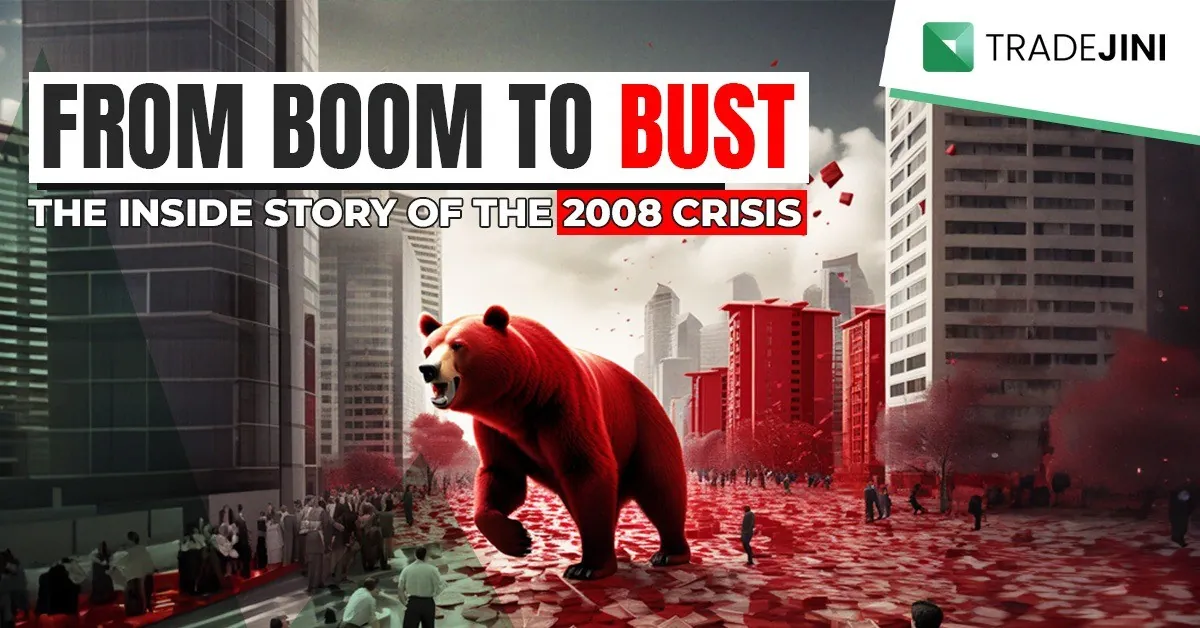The year 2008 marked the most challenging time in the world of money. You might have read phrases like "subprime mortgage crisis," "credit crisis," and "bank collapse" in the news. These events had a big impact on the economy, and we're going to take a closer look at what happened, why it happened, and how it affected people around the world.
How it started
Let's rewind to the late 1990s, when the U.S. government wanted more people to own homes. They thought it was a good idea to make it easier for folks with not-so-great credit scores to get home loans. The companies helping with this were Fannie Mae and Freddie Mac. They gave loans to people who were seen as risky, and these were called "subprime borrowers."
These subprime borrowers got loans with low starting interest rates, but these rates would go up after a few years. It seemed like a good idea to help more people become homeowners, but the risky mortgages had unconventional terms, meaning the rules were a bit different, like higher interest rates and variable payments.
In early 2002, some experts were worried. They thought the whole mortgage market was like a house of cards, and if people lost confidence, everything would crash down.
The trouble begins
A big part of the problem was the type of mortgage given to subprime borrowers. Some were adjustable-rate mortgages (ARMs), which had low initial payments that would later shoot up. There were interest-only ARMs and payment option ARMs, where borrowers could make lower payments at first but faced bigger ones later. When the housing market was doing well, these mortgages seemed fine. But when home values dropped, people couldn't sell their homes for a profit, and they were stuck with higher payments they couldn't afford.
To make matters worse, total consumer debt was growing fast. In 2004, it hit $2 trillion for the first time, which meant people were struggling with their mortgage payments and also had other debts.

The rise of mortgage-related investments
Down the line, home prices started increasing. Investors were interested in making money from the housing market. They started buying mortgage-backed securities (MBS), bundles of mortgages that were sold as investments. As long as home prices kept increasing and people paid their mortgages, investors made money.
Another thing that became popular was credit default swaps (CDS). These were like insurance against companies not being able to pay back their debts. However, unlike regular insurance, the CDS market had no rules. This became a big problem when American International Group (AIG), a major financial company, couldn't pay its debts in 2008.
Markets declined, and companies failed
By March 2007, things started falling apart. Companies like Bear Stearns failed because they had big losses from risky investments linked to the subprime mortgage market. Homeowners were struggling to make payments, and the housing market was in trouble.
Despite these warning signs, the stock market rallied until October 2007. By December 2007, the United States was officially in a recession. In July 2008, the Dow Jones Industrial Average dropped below 11,000 for the first time in over two years, indicating that the decline was not over.
Many people who got adjustable-rate subprime mortgages were in trouble. When their low initial rates went up, they couldn't afford the higher payments. By September 6, 2008, the government had to take over Fannie Mae and Freddie Mac to prevent more losses in the subprime mortgage market.
A week later, on September 14, Lehman Brothers, a big investment bank, went bankrupt because it invested heavily in subprime mortgages. This was the largest bankruptcy in U.S. history at the time. The markets reacted strongly, and the Dow closed down almost 500 points.
Lehman's collapse triggered chaos
Lehman Brothers' collapse had a domino effect. The Reserve Primary Fund, a money market fund, faced problems, and its value fell below $1 per share. People panicked and withdrew their money. Bank of America announced it was buying Merrill Lynch and the credit rating for American International Group (AIG) was downgraded.
On September 18, 2008, talks of a government bailout caused the Dow to go up by 410 points. The next day, Treasury Secretary Henry Paulson proposed a $1 trillion Troubled Asset Relief Program (TARP) to buy bad debts and prevent a complete financial meltdown.
Despite these efforts, the financial turmoil escalated. The Dow dropped 3,600 points in three weeks, and significant events unfolded:
Goldman Sachs and Morgan Stanley became bank-holding companies for better bailout funding.
The Federal Deposit Insurance Corporation (FDIC) seized Washington Mutual after a 10-day bank run.
The TARP bailout plan stalled in Congress, creating more uncertainty.
The Dow had its largest point drop in history, losing 774 points in one day.
A reworked TARP plan passed in Congress, and the Dow closed below 10,000 for the first time in years.
Learning from the Past
In 2008, the housing market faced a crisis with subprime mortgages, high consumer debt, and falling home values. Homeowners couldn't make payments, leading to foreclosures. Today, even if concerns about high mortgage rates and a possible recession exist, the housing market is not entirely like 2008. Homeowners have better credit, more home equity, and fixed low mortgage rates.

Global Impact
The 2008 financial meltdown started with U.S. subprime mortgages but turned into a global banking crisis when Lehman Brothers collapsed. Britain's largest corporations lost £90 billion in a day. The crisis began with speculation in real estate transactions and cheap credit, and the subprime mortgage market, initially seen as risk diversification, became a disaster as defaults increased.
Government bailouts, starting with Bear Stearns and extending to Fannie Mae, Freddie Mac, and Lehman Brothers, were responses to the crisis. The unregulated credit default swap (CDS) market added complexity, and Lehman Brothers bankruptcy triggered a chain reaction, affecting the global financial system.
Examining the Fallout
Multiple factors contributed to the 2008 stock market crash. The accumulation of bad debt led to government bailouts, with Lehman Brothers falling due to its exposure to subprime mortgages. The unregulated credit default swap (CDS) market posed a risk, and each bailout announcement caused market uncertainty. The Senate's rejection of the bank rescue measure led to the Dow's historic drop, creating global instability.
Consequences of the 2008 Financial Crisis
The aftermath of the 2008 financial crisis was significant. Unemployment claims surged, and the U.S. economy lost trillions in wealth. Economic inequality widened, and the government intervened with the Troubled Asset Relief Program (TARP), providing financial aid to major companies.
The Path Back to Wholeness
The year 2009 marked a turning point as President Obama's economic stimulus package instilled confidence. The Dow fluctuated but eventually recovered, emphasizing the long-lasting impact of the 2008 stock market meltdown.
Crisis to remember
As we look back on the difficult 2008 period, it's important to put responsible financial practices first and provide regulatory oversight to prevent future crises. The recovery was slow, underscoring the resilience of economies and the need for proactive measures to ensure economic stability. The 2008 financial crisis remains a reminder of the fragility of financial systems and the ongoing importance of awareness in promoting economic well-being.



